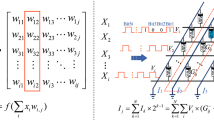Abstract
Due to the bionic features, neuromorphic computing has achieved higher energy efficiency than deep learning in many fields in recent years. Similar to the biological brain, the memory of synapses and weights occupy a large area in a neuromorphic processor. The prior neuromorphic processors meet the challenge of the large area of the memory organization. In this work, based on the characteristics of the brain and spiking neural networks (SNNs), we propose a set-associative memory organization and a compressed SRAM memory organization with an adjacent matrix of synapses for loose and tight coupling structures in SNN respectively to construct an area-efficient memory organization for generalized neuromorphic architectures. A ping-pong memory is also proposed for the logic neuron number expansion. Experiments show that our methods use less chip area and consume less power than the CAM implementation in related work by 23.4–75.8% and 21.2–75.7% while bringing minor processor performance overhead.










Similar content being viewed by others
References
Akopyan, F., et al.: Truenorth: design and tool flow of a 65 mw 1 million neuron programmable neurosynaptic chip. IEEE Trans. Comput. Aided Des. Integr. Circuits Syst. 34(10), 1537–1557 (2015)
Amir, A., Datta, P., Risk, W.P., Cassidy, A.S., Kusnitz, J.A., Esser, S.K., Andreopoulos, A., Wong, T.M., Flickner, M., Alvarez-Icaza, R., McQuinn, E., Shaw, B., Pass, N., Modha, D.S.: Cognitive computing programming paradigm: a corelet language for composing networks of neurosynaptic cores. IEEE Computational Intelligence Society (IEEE-CIS); International Neural Network Society (INNS)
Amir, A., et al.: A low power, fully event-based gesture recognition system. In: 2017 IEEE Conference on Computer Vision and Pattern Recognition (CVPR), pp. 7388–7397 (2017)
Andrew, A.M., et al.: Spiking Neuron Models: Single Neurons, Populations, Plasticity, vol. 32. Emerald Group Publishing Limited, Bingley (2003)
Barboza, R.: Alternative circuit model for the hodgkin-huxley nerve axon. In: Proceedings of the Twelfth Annual International Conference of the IEEE Engineering in Medicine and Biology Society, pp. 1855–1856 (1990)
Burkitt, A.N.: A review of the integrate-and-fire neuron model: I. Homogeneous synaptic input. Biol. Cybern. 95(1), 1–19 (2006)
Cassidy, A.S., Merolla, P., Arthur, J.V., Esser, S.K., Jackson, B., Alvarez-Icaza, R.D.P., Sawada, J., Wong, T.M., Feldman, V., Amir, A., Rubin, D.B.-D., Akopyan, F., McQuinn, E., Risk, W.P., Modha, D.S.: Cognitive computing building block: A versatile and efficient digital neuron model for neurosynaptic cores. IEEE Computational Intelligence Society (IEEE-CIS); International Neural Network Society (INNS) (2013)
Davies, M., et al.: Loihi: a neuromorphic many-core processor with on-chip learning. IEEE Micro 38(1), 82–99 (2018)
de Azambuja, R., et al.: Short-term plasticity in a liquid state machine biomimetic robot arm controller. In: 2017 International Joint Conference on Neural Networks (IJCNN), pp. 3399–3408 (2017)
DeWolf, T., Jaworski, P., Eliasmith, C.: Nengo and low-power ai hardware for robust, embedded neuro-robotics. Front. Neurorobot. 14, 568359 (2020)
Eliasmith, C., et al.: A large-scale model of the functioning brain. Science 338(6111), 1202–1205 (2012)
Holmgren, C., Harkany, T., Svennenfors, B., Zilberter, Y.: Pyramidal cell communication within local networks in layer 2/3 of rat neocortex. J. Physiol. 551(1), 139–153 (2003)
Ijspeert, A.J.: Central pattern generators for loco-motion control in animals and robots: a review. Neural Netw. 21(4), 642–653 (2008)
Izhikevich, E.M., et al.: Large-scale model of mammalian thalamocortical systems. Proc. Natl. Acad. Sci. USA 105, 3593–3598 (2008)
Kim, S., et al.: Spiking-YOLO: spiking neural network for energy-efficient object detection (2019)
Kulkarni, S., et al.: A spiking neural network (snn) forecast engine for short-term electrical load forecasting. Appl. Soft Comput. 13(8), 3628–3635 (2013)
LeCun, Y., et al.: The mnist database of handwritten digits, 10:34. http://yann.lecun.com/exdb/mnist (1998)
Mead, C.: Neuromorphic electronic systems. Proc. IEEE 78(10), 1629–1636 (1990)
Merolla, P., Arthur, J., Akopyan, F., Imam, N., Manohar, R., Modha, D.S.: A digital neurosynaptic core using embedded crossbar memory with 45pj per spike in 45nm (2011)
Moradi, S., Qiao, N., Stefanini, F., Indiveri, G.: A scalable multicore architecture with heterogeneous memory structures for dynamic neuromorphic asynchronous processors (DYNAPs). IEEE Trans. Biomed. Circuits Syst. 12(1), 106–122 (2018)
Orchard, G., et al.: Converting static image datasets to spiking neuromorphic datasets using saccades. Front. Neurosci. 9, 437 (2015)
Stimberg, M., et al.: Equation-oriented specification of neural models for simulations. Front. Neuroinform. 8, 6 (2014)
Thakor, N.: Translating the brain–machine interface. Sci. Transl. Med. 5, 210ps17 (2013)
Wang, L., et al.: LSMCore: a 69k-synapse/mm\(^{2}\) single-core digital neuromorphic processor for liquid state machine. IEEE Trans. Circuits Syst. I Regul. Pap. 69(5), 1976–1989 (2022)
Yang, Z., et al.: CompressedCache: enabling storage compression on neuromorphic processor for liquid state machine. In: He, X., Shao, E., Tan, G. (eds.) Network and Parallel Computing. NPC 2020. Lecture Notes in Computer Science, vol. 12639. Springer, Cham (2021)
Zhang, L., Zhang, B.: A geometrical representation of mcculloch-pitts neural model and its applications. IEEE Trans. Neural Netw. 10(4), 925–929 (1999)
Acknowledgements
On behalf of all authors, the corresponding author states that there is no conflict of interest. This work is funded by National Key Research and Development Programs of China [Grant numbers 2018YFB2202603 and 2020AAA0104602].
Author information
Authors and Affiliations
Corresponding author
Rights and permissions
Springer Nature or its licensor holds exclusive rights to this article under a publishing agreement with the author(s) or other rightsholder(s); author self-archiving of the accepted manuscript version of this article is solely governed by the terms of such publishing agreement and applicable law.
About this article
Cite this article
Yang, Z., Wang, L., Wang, Y. et al. Lotus: a memory organization for loose and tight coupling neurons in neuromorphic architecture. CCF Trans. HPC 4, 448–460 (2022). https://doi.org/10.1007/s42514-022-00113-z
Received:
Accepted:
Published:
Issue Date:
DOI: https://doi.org/10.1007/s42514-022-00113-z




